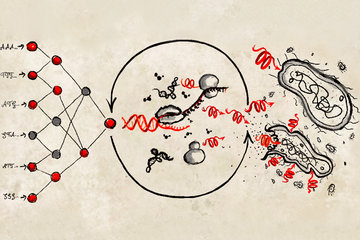Order for brewer`s yeast
An artificial chromosome combines all t-RNA genes for cellular protein production
For years, researchers have been working to synthetically recreate the genome, or more precisely, the chromosomes of brewer's yeast. Now it has been possible to combine all transfer RNA genes in an artificial chromosome. The result sets a milestone in the development of the first synthetic eukaryotic genome and opens up new avenues for basic research.

In a collaboration led by the Manchester Institute of Biotechnology, researchers from the Max Planck Institute for Terrestrial Microbiology have succeeded in producing a tRNA neochromosome of brewer's yeast that does not occur in nature. This success marks a milestone in the international synthetic yeast genome project (Sc2.0). The large consortium has the objective of synthesizing all 16 natural chromosomes of the baker's yeast Saccharomyces cerevisiae and then combining them to form a completely synthetic cell. The synthesis of all chromosomes has now been completed and these have been published in several articles in renowned journals.
Yeasts have become an integral part of industrial biotechnological processes. They produce biofuels, pharmaceuticals, flavorings and fragrances and have been used for thousands of years to bake bread and brew beer. While the construction of an artificial bacterial genome has already been achieved, the situation with brewer's yeast is far more complicated. As a Eukaryote, it has a cell nucleus, just like humans, and its genes are organized in several chromosomes. The genome size is also generally many times larger.
Resetting evolution
But the organization is limited, explains Daniel Schindler, head of a research group at the Max Planck Institute for Terrestrial Microbiology in Marburg and the Center for Synthetic Microbiology, who is co-first author of the study. "Although the genes are functionally connected, they are scattered across all chromosomes in the natural genome. This is because evolution is not directional, but each new state builds on the previous one. With synthetic biology, we can reset evolution, so to speak. By building the chromosomes from scratch, we can bring all the relevant tRNA genes together, sort them and create our own order." Selecting only the necessary genes increases the robustness of strains. In addition, the copy number, i.e. the number of genes that code for a product, can be controlled. This avoids ballast, which slows down cell growth.
The new chromosomes could also store information that does not occur in nature. This opens up completely new possibilities for basic research. It is now possible to find out which genes are really necessary or which functions they really have. Researchers can also specifically create new strains. "For example, we can identify genes that are responsible for the tolerance of certain salt concentrations or temperatures in order to improve the properties of the strains," explains Daniel Schindler.
Fully synthetic yeast cell
The international team also reported the successful combination of six and a half synthetic chromosomes in a functioning cell. The tRNA neochromosome has the task of storing and organizing all 275 yeast nuclear tRNA genes. It will later be incorporated into the fully synthetic yeast, where the tRNA genes have been removed from the other synthesized chromosomes.
"The remarkable thing about this project is the level of collaboration and interdisciplinarity with which it is being carried out. Not only are our experts here in Manchester involved, but experts from all over the world, from biology and genomics to computer science and bioengineering," says Yizhi Cai, head of the Synthetic Genomics Department at the Manchester Institute of Biotechnology at the University of Manchester and international coordinator of the Sc2.0 project.
Daniel Schindler adds: "The international Sc2.0 project involves basic research to expand our understanding of genomic principles, but also paves the way for future applications in biotechnology and drives technology development." Developments in molecular genetics and high-throughput technologies also contribute to this, as Daniel Schindler emphasizes. "In the past, our goals used to be on the edge of what was feasible and were very expensive. Now we can do the same work in a quarter of the time and at a much lower cost."












